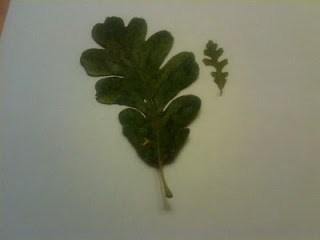(Click to enlarge - but it will be blurry)
This valley oak leaf came from the fast growing (but poorly photographed) valley oak I mentioned in a previous post:
Planted as an acorn 5 growing seasons ago, now 20 feet tall. The leaf shown above was typical in size for this tree... which is to say tiny:
Adorable little thing isn't it? As you can see from the photograph above, the total leaf surface area of that young but fast growing valley oak is relatively small. You wouldn't think by looking at it that it would have the photosynthetic surface area necessary to fuel that kind of growth. But what these leaves lack in surface area they make up for in thickness; they are little power packs of energy.
As with all oak "species" (a term regular readers know that I use loosely since I view the entire oak genus as a single species with a continuum of traits, rather than as hundreds of species with thousands of hybrids), there is an enormous amount of variation in valley oak leaf size and morphology:
I collected the larger leaf from a valley oak just a few miles away (and yes, I still owe you the story behind that tree). Think those two fully developed, late-season leaves can't be from the same "species"? Think again.




No comments:
Post a Comment